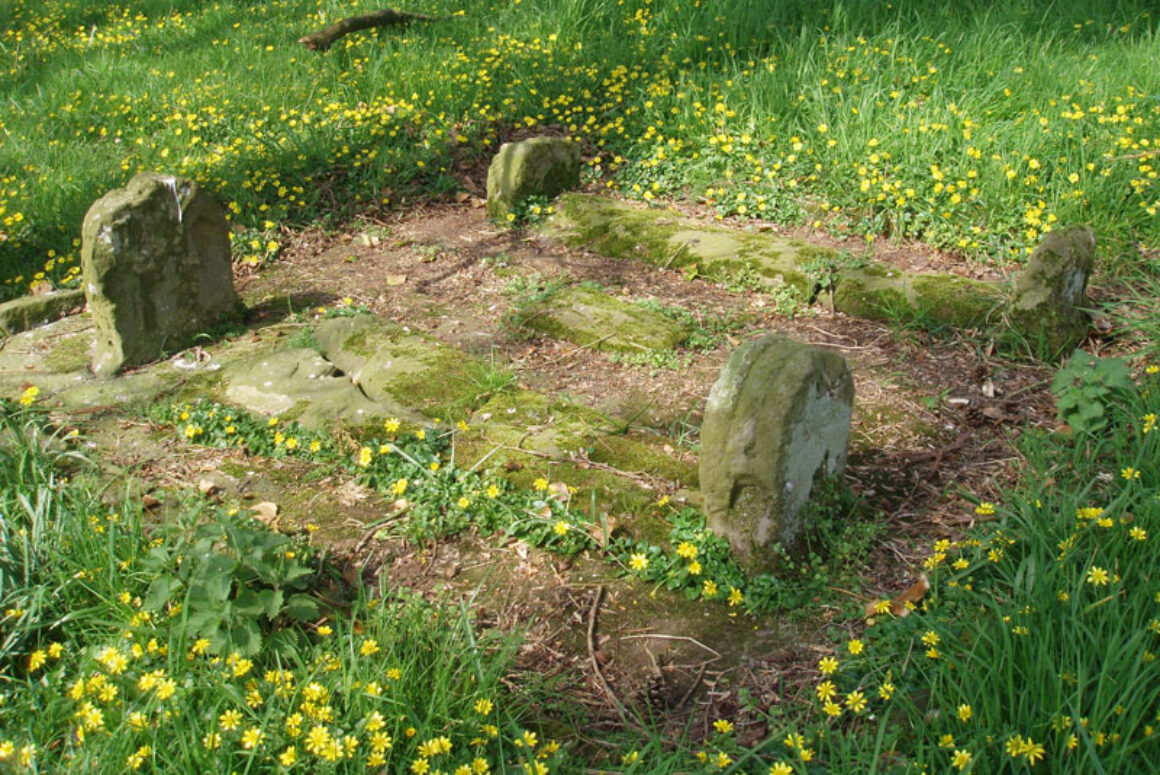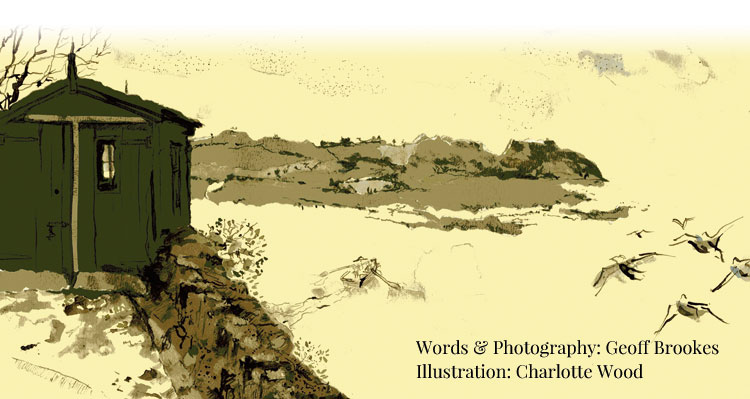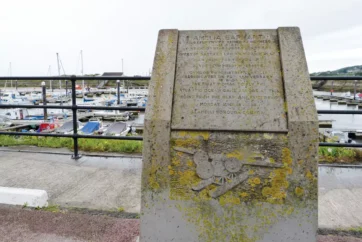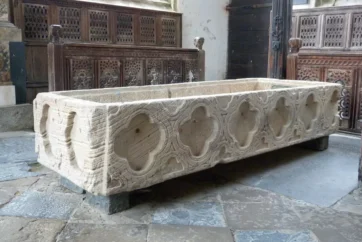![]()
Geoff Brookes travels to Llanfihangel Abercowyn, Carmarthenshire to find six mysterious medieval graves
It is a modern road that leads us from Carmarthen to St. Clears, in south-west Wales. Fast and efficient it takes us quickly to the west towards St. David’s at the very edge of Wales, but the A40 is also a road that takes us deep into the past. Just before St. Clears there is a junction by the church, in the village of Llanfryn, where you must turn left and take a single track road. Drive for about 2 kilometres until the road swings sharply to the left, signposted Llansteffan. Ignore the turning and drive straight on, which will lead you directly into a farmyard. Park carefully and mind the dogs who will snap at your tyres, they may sound fierce, but we found them harmless. You must ask for permission to see the graves at the farmhouse, where the tenants are very accommodating.
Trefenty House is a large and solid building, that seems strong enough to have been there forever. Yet the graves we came to see have lain there, silently and untroubled, for much longer. You walk through the yard and, once through the gate, follow the slope round and down towards the estuary. There is a beautiful view of the river Taf and all you will hear are the cows and the gulls. Just around the bend of the river in front, you will find the pretty little town of Laugharne, where the Welsh poet Dylan Thomas sat in his boathouse, above the tide and wrote. His creation was a fictional world, although based completely upon what had happened to him and the people he knew. Yet here you feel separated from everything. There is nothing else to be seen other than the landscape, no houses, no people, just the river and the hills that have always been there. Apart, of course, from the ruins of St. Michael’s, an ancient church, sited at the mouth of the river Cowyn, where it flows into the Taf. More properly known in Welsh as, Llanfihangel Abercowyn, a lost church for a lost community. Look at the map and you will see that it is on the west bank of the Cowyn. Many of the original parishioners would have arrived by boat, from across the estuary. A beautiful and isolated spot, a romantic ruin. If it wasn’t so far from the road it would be an ideal spot for wedding photos, that and the cows, of course.
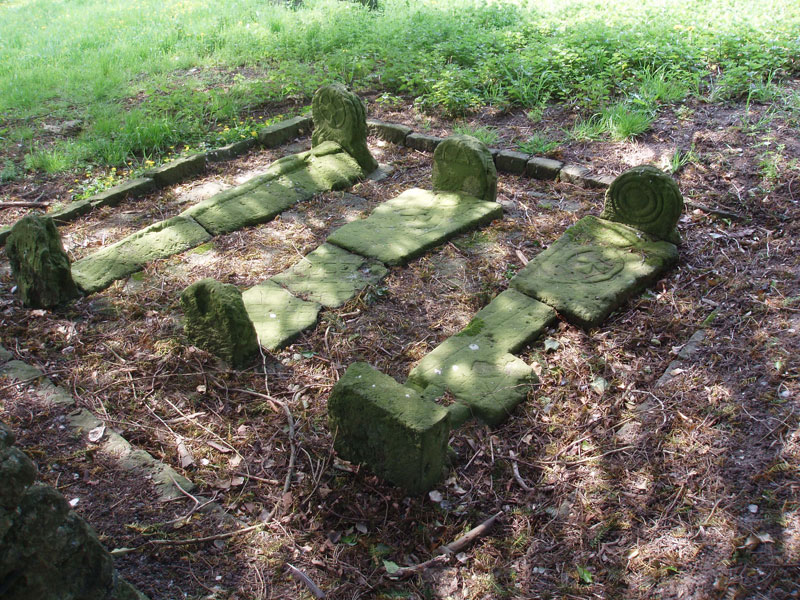
It is not entirely overgrown. The cemetery emerges from the unkempt grass, speaking of a lost time. The settlement the church served, has long since disappeared. It was where the farmhouse is now, alongside the old motte that was once a castle. There is no evidence of any masonry there, so it was probably nothing more than a stockade. But, people lived and died here, leaving behind forgotten stories.
It was once a place with ‘an air of cheerfulness and activity, from the frequent passing of travellers’. They were more often than not, pilgrims following the route to St. David’s Cathedral, to visit the relics of the patron saint of Wales.
St. David’s, the smallest cathedral city in the United Kingdom, was for a long time an important pilgrimage centre. Indeed, although he was not canonised until 1120, the shrine to David, the patron saint of Wales, had been visited by the great and the good for many centuries. William the Conqueror went there, followed later by other kings of England. It was an inaccessible place and thus something of a challenge. In fact two visits there, were seen as the equivalent to one pilgrimage to Rome. It was all about indulgences. Make a pilgrimage to Rome, or Santiago de Compostela in Spain, or St. David’s and you could significantly reduce the time your soul would spend in purgatory – a real bargain – and an offer you couldn’t afford to miss. But, when you became exhausted it must have seemed a very long way indeed, as you struggled into the rain, that beat in from the west. Perhaps Rome was a better offer after all.
David was born and grew up in the west. He probably died on 1st March 588 AD, St David’s Day. It isn’t a surprise that his story and his life remain obscure. Was he really a relative of the great King Arthur as some say? How can we know? But, his pious monasticism as an abbot turned him, 500 years later, into a saint. His bones, objects of veneration, were apparently mingled in an iron-bound chest, with those of his teacher St. Justinian. Such are the rewards of hard work and contemplation, a life based apparently on a never changing diet of bread and water. It is said, that as a self-imposed penance he would stand up to his neck in a lake of cold water, reciting the Bible. As a hobby it never really caught on, but a visit to the places where this venerated man tried to speak to God could bring you closer to heaven. Thousands made the effort.
The original church of Llanfihangel Abercowyn was begun in the 12th century and was later extended, probably to accommodate the visiting pilgrims. At the back of the ruined church, underneath the protective spread of an ancient yew tree, the first three medieval graves are still neat and ordered. The three graves are in a line, mysterious, holding secrets. Further down the slope you will find another group of three. They are much better preserved than many of the other stones from the eighteenth century that you can find in the grass. Local people with their names displayed for prosperity. Who lies underneath these older ones we cannot say. Naturally there are stories. The graves themselves are well known, even if the people within them are not.
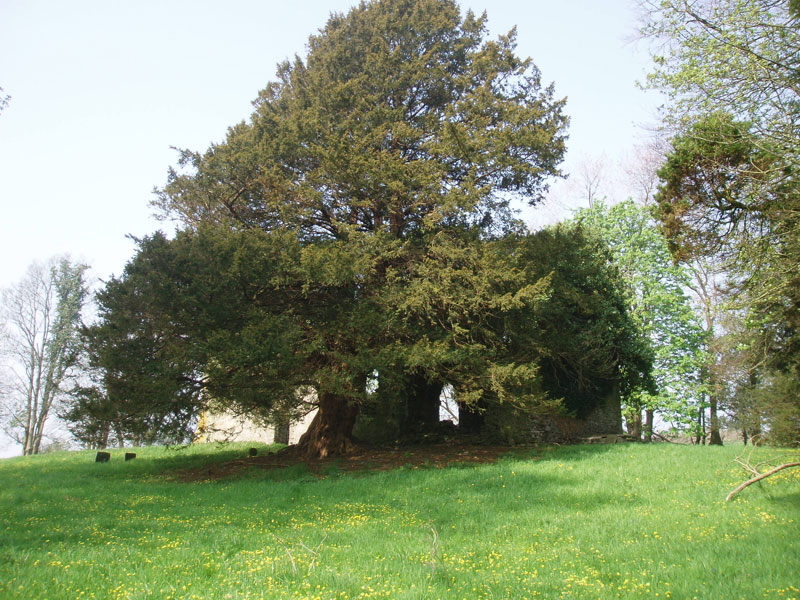
The six gravestones are traditionally said to be those of 12th Century pilgrims who died here. They are, according to a 19th Century guidebook, ‘objects of much superstitious veneration’. The story that has been handed down is that three pilgrims, meeting ‘in great destitution’ prepared three graves. They agreed that two of them should be put to death and the third, after burying them, should lie down in the third grave and pull a large stone over himself. The reason this stone is ‘imperfectly placed’ is because his strength failed him at the last moment.
In 1839 the middle grave was opened and the bones of a young person were revealed, along with a few large scallop shells, a traditional symbol of a pilgrim to Santiago de Compstela in Spain. Just imagine, to conquer the Pyrenees and then to succumb to fatigue, in the gentle green of Wales. In the spring sunshine it is hard to believe that here someone could have starved. It doesn’t seem possible, it is not so remote. In fifteen minutes I can be in St. Clears. Yet it was such a different world then, a less ordered landscape. In the driving rain and the wind, that are so much a feature of this place, who knows how abandoned and hopeless someone could have felt. Crossing the Taf’s treacherous tides, still days away from St. David’s, cold and wet and dark…

A short distance down the slope to the river there is a second set of three tombs. The graves have flat carved slabs, showing faded male and female figures, carrying either weapons or pilgrim staves. The smaller stone in the middle may indicate the grave of a child. The head and footstones, which are about 40cm high, carry figures of knights on horseback. These could be the graves of a family, perhaps even a noble one. But we don’t know who they are. The simple unsophisticated designs of the graves hide a secret. There is no writing on them, there probably never has been.
This is truly a forgotten and mysterious place. Full of questions to which we will never know the answers. There can be no doubt that this is a beautiful place. Untouched. You look out to the green hills and wonder how much has changed since those beneath the old stones, themselves looked across the river.
Very little because, as you look out across the river you can see nothing of today.
According to local belief this small peninsular between two pure and ancient rivers will ‘be free from all noxious animals and reptiles, so long as the tombs are kept free from weeds’.
All I can say is that the tombs are neat and clear and we saw no noxious animals anywhere the whole time we were there……


